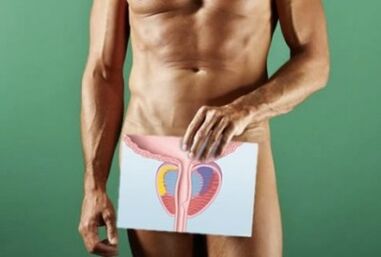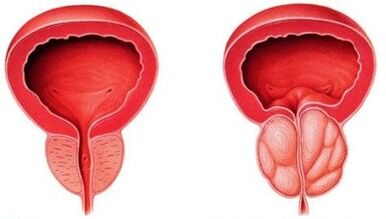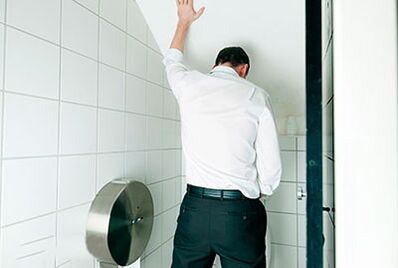Prostatitis is a disease that can suddenly strike every man.
The urinary tract passes through the prostate gland, contributing to the manifestation of one of the first signs of the disease - difficulty urinating.
Prostatitis - the beginning
The onset of the disease is always associated with certain circumstances of our life.
There are several types of prostatitis:
- Sharp;
- Chronic;
- Infectious (bacteria);
- Not contagious.

In this case, the nomenclature is binary, for example, infectious prostatitis can be chronic and acute.
Each type of prostatitis will start differently and will be heralded by its own circumstances. Let's look at them.
Risk factors, circumstances occurring
- STDs. When a man gets infected with any sexually transmitted infection from his partner, a man has a great chance of acquiring an acutely infectious prostate gland, which can then turn into chronic. Thus, sexually transmitted diseases will be the first factor leading to prostatitis.
- Sedentary lifestyle, sedentary work, indifference to sports and morning exercise, obesity. This is the cause of a non-infectious prostatitis, which may become worse or with vague symptoms.
- Hypothermia - in this case, the genitourinary system is subjected to frequent colds, so the bladder, vas deferens, prostate, and testicles can become inflamed.
- Age. When a man reaches 40-45 years old, irreversible changes begin in his prostate gland. The cause is male menopause - a direct result of the rearrangement of the hormones in the body. A prostate gland develops (hyperplasia), accompanies (or may be accompanied by) a full spectrum of prostatitis symptoms.
Let's generalize again - these factors increase the risk of prostatitis by 10 times.

Next, let's look at the first signs of prostatitis types.
Attention, before self-diagnosis at the first signs, or panic seek to contact a doctor - pay attention to the above risk factors. You probably don't have prostatitis!
The symptoms
Process acute
Let's clarify that the first signs of acute prostatitis are in most cases the same in all patients:
- Pain during urination, burning after;
- Increased temperature;
- After aggressively emptying the bladder, the patient feels urine remains;
- Complaints pain in the groin and perineum.
The stains started suddenly, so did the problems with the toilet. This is due to a rapid proliferation of an inflamed prostate gland.

Symptoms may go away on their own, but do not produce an illusion: this does not mean that the disease has gone away.
Prostatitis becomes chronic. It can take a long time (years) from the first sign of acute prostatitis to the onset of chronic prostatitis.
Chronic process
Perhaps the patient does not have a pronounced acute episode, and the disease, ignores it, turns into a chronic form.
In this case, the symptoms would be as follows:
- Dull pain in the anus after a bowel movement, spreading to the coccyx;
- Frequent or unusual groin pain;
- Going to the bathroom is not particularly difficult, but it may take a little stretching of your stomach to start urinating. The patient does not pay much attention to this;
- Sometimes, after urinating, a burning sensation is felt in the urethra.
The first signs of chronic prostatitis can appear for a long time. They may disappear, then make themselves feel again.
Infectious prostatitis
Often when infected with prostatitis, patients also carry other sexually transmitted diseases.
Among the first signs should be highlighted:
- Removal of the urethra, blood in urine;
- Increased temperature;
- White urine (pus)
- Constantly urge to go to the toilet.
The first signs of bacterial prostatitis are similar to acute prostatitis, since the latter usually occurs precisely due to an infectious agent.

Prostatitis is not contagious
After 40 years, a man may find the first signs of a non-infectious prostatitis. This is not the fault of the bacteria, just the time has come.
An enlarged prostate gland may somehow manifest itself or go unnoticed.
If a man is having problems, they will show symptoms like:
- Difficult urination
- The amount of urine in the bladder.

If it causes prostatitis, then pain, burning and possible fever.
Any inflammatory prostate disease has an underlying (primary) manifestation of the problem of urination. The pain can be of different position and intensity, burning pain when urinating, and then may not be present.
Sexual problems occur in 99 out of 100% of cases, but the process takes a few years or more.
Among the first signs, there is weakening of urine pressure. If you have to stretch your abdominal muscles to start urinating (even if you don't notice it), then it's time to see a urologist.
This is the first sign of an impending prostatitis.
What if you ignore all of these symptoms?
Suppose the acute prostatitis has gone away on its own (imagine that it is gone).
After days of torture, it was easy for us to go to the toilet again, and the burning and painful sensations left us.
The euphoria will not last - chronic inflammation is attached to the prostate gland, so prostatitis will still remind itself.
This is not the worst, as you can live with such feelings. What is important is what happens inside the prostate gland.
Let's remember what its function is - maintaining the vital functioning of the sperm.
Prostatitis inhibits and blocks this function. As a result of progressive prostatitis, a man may lose the ability to fertilize.

Another unpleasant consequence of advanced prostatitis is depression and poor mood. Problems with the toilet constantly add to a man's stress.
Incomplete bladder emptying leads to inflammatory processes in it and other parts of the urinary system.
So, don't be idle.
How to detect prostatitis?
At the first sign of the disease, contact your urologist and tell us how you are feeling.
Prostatitis is diagnosed with a history, rectal examination of the prostate gland and TRUS.
The rest of the methods are used as an adjunct, to identify concomitant diseases or to eliminate them.
You can diagnose it at home. But prostatitis can be confused with urethritis or bladder inflammation, so read the diagnosis of prostatitis carefully.
Treatment
Treatment of prostatitis depends on its form.
The main task of the doctor is:
- Restore normal ureter. This means you need to reduce swelling, reduce muscle spasms and stimulate urine production and urination.
- Fight off infectious agents or eliminate the cause of prostatitis.
- Prevent recurrence (good diet, lifestyle and habits).
- Stimulates the activity of the prostate gland - massages the prostate rectum.
You can also be treated at home, having previously agreed on a treatment method with a urologist. For example, it is very helpful to order special differential pills with herbal decoctions.
To speed up recovery, the doctor will prescribe physical therapy.



























